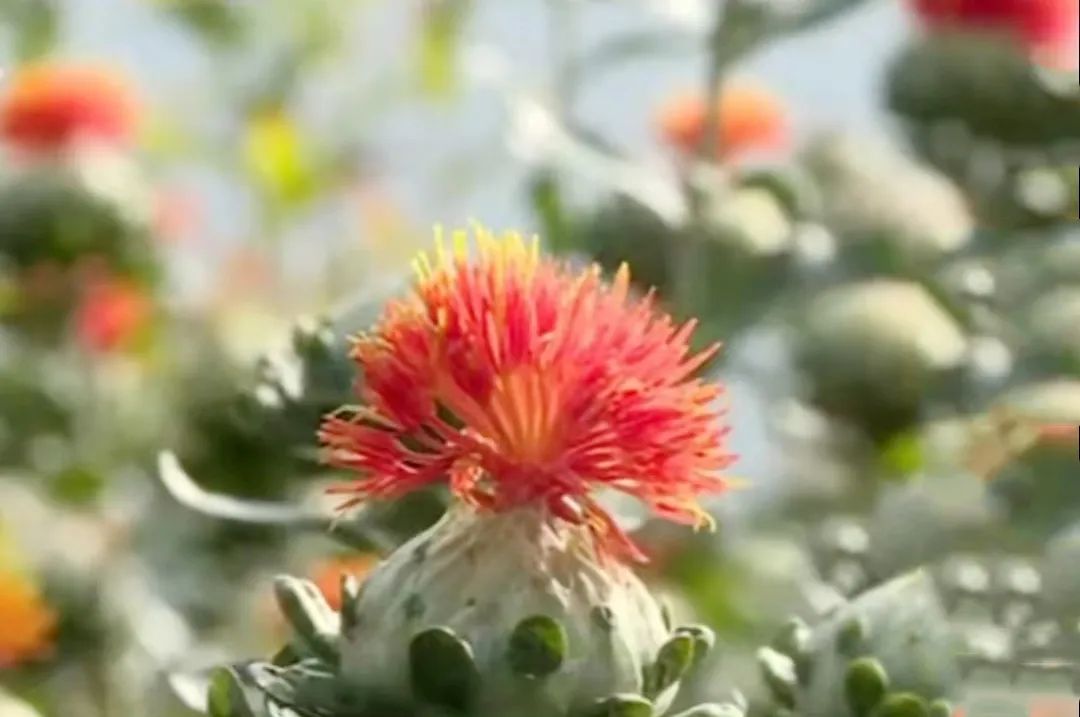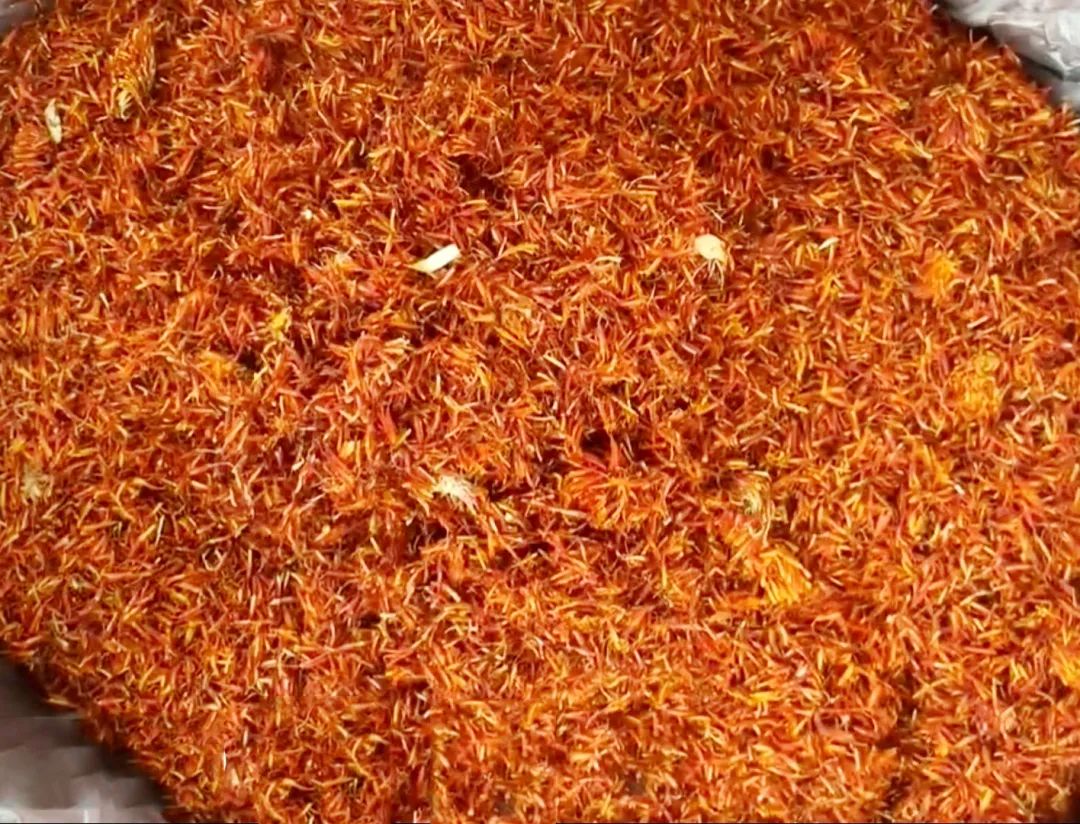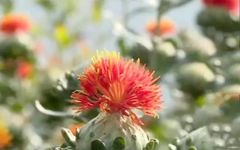


Safflower (Carthamus tinctorius) is cultivated worldwide, with various types categorized generally into ornamental, oil-producing, and dual-purpose varieties. In China, safflower is primarily cultivated for medicinal use, with the main varieties being:
(1) “Du Hong Hua” (杜红花)
This variety is mainly distributed in Jiangsu and Zhejiang provinces, with a height of 80-120 cm; it has 27-30 branches; 30-120 flower heads; long petals; narrow leaves with many sharp thorns, and produces high-quality dried flowers that are golden yellow.
(2) “Huai Hong Hua” (怀红花)
This variety is mainly found in Henan province, with a height of 80-120 cm; it has 6-10 branches; 7-30 flower heads; short petals; large flower heads; shallowly notched leaves with few blunt thorns.
(3) “AC-1 Wu Ci Hong” (AC-1无刺红)
This variety is mainly distributed in Xinjiang, selected from the introduced AC-1 variety, characterized by thornless plants and red flowers; it has 4-6 branches; the seed oil content reaches 44.8%; it is an excellent dual-purpose variety.
(4) “Da Hong Pao” (大红袍)
This variety is from Yanjin County, Henan Province, with a height of nearly 90 cm; it has thornless leaf edges; the flowers are bright red. This variety is characterized by strong branching ability, many flower buds, and strong resistance, with an oil content of 25.4%, making it an excellent dual-purpose variety.
(5) “UC-26” (UC-26)
Introduced from the United States by the Beijing Botanical Garden in 1978, this variety is characterized by a small angle between branches and the main stem, suitable for dense planting; it has thornless leaf edges, and a higher number of flower heads per unit area, resulting in higher flower yield. Its disadvantage is a low seed oil content, primarily cultivated for flower harvesting.
 (6) “Chuan Hong 1 Hao” (川红1号)
(6) “Chuan Hong 1 Hao” (川红1号)
This high-yield variety was bred by the Sichuan Institute of Traditional Chinese Medicine, characterized by a height of about 124 cm, thorny plants, low and numerous branches, and orange-red flowers. Among the above safflower varieties, “Da Hong Pao”, “Chuan Hong 1 Hao”, “AC-1 Wu Ci Hong”, and “UC-26” are excellent varieties. The oil-producing safflower is primarily used for oil extraction, with more applications abroad, mainly distributed in India, Mexico, and the United States. In China, oil-producing safflower is mainly found in Xinjiang, characterized by high seed oil content. The main varieties include:
(1) “UC-1” (UC-1)
This variety is characterized by early maturity, thorny plants; the flowers are yellow; with a thousand seed weight of 45 g, and an oil content of up to 36.72%, while also having certain flood resistance. The proportions of oleic acid, linoleic acid, stearic acid, and palmitic acid in this variety differ from typical safflower, resembling that of olive oil, at 15.2%, 78.3%, 1.2%, and 5.3%, respectively.
(2) “AC-1” (AC-1)
This early-maturing variety was selected from the Beijing Botanical Garden of the Chinese Academy of Sciences, with a high oil yield of up to 42%, and an oleic acid content of 82.2%. This variety grows to about 100 cm, is thorny, and the flowers start yellow and later turn orange-red, suitable for cultivation in Northwest China. Its disadvantage is poor resistance to stress, making it susceptible to root rot.
(3) “You Te” (犹特)
This variety was introduced from the United States in 1977, characterized by many branches, small flower heads, and seeds; the flowers start yellow and later turn orange, with a thousand seed weight of 31.5 g and an oil content of 35.8%, yielding high production and strong resistance to rust and root rot.
(4) “Li De” (李德)
This variety was also introduced from the United States in 1977, characterized by orange-red flowers, a thousand seed weight of 40 g, and an oil content of up to 35.79%, yielding higher than varieties like “You Te”. It also has strong resistance to rust and root rot.
(5) “Mo Xi Ge Ai” (墨西哥矮)
This variety was introduced to China in 1978, characterized by being thornless, small flower heads, and large seeds, with a thousand seed weight of 69 g and an oil content of 26.3%. It is not sensitive to the length of daylight, making it suitable for cultivation in southern China, especially in regions with three crops per year. Its disadvantage is low seed oil content.

 Safflower is drought-resistant but sensitive to waterlogging; it should be planted in high, dry, well-drained areas with deep, moderately fertile soil, with a pH of 7-8. Areas with high groundwater levels and heavy clay soils are unsuitable for safflower cultivation. Safflower is susceptible to pests and diseases, and crop rotation is recommended to avoid continuous cropping. It can be rotated with corn, soybeans, and potatoes for 2-3 years. The root system of safflower can reach over 2 meters, so deep plowing is necessary, reaching 25 cm, and applying 2000 kg of well-rotted farmyard manure and 20 kg of superphosphate as base fertilizer per mu. In areas with heavy rainfall, high ridges of 1.3-1.5 m should be constructed, with drainage ditches around to facilitate drainage.
Safflower is drought-resistant but sensitive to waterlogging; it should be planted in high, dry, well-drained areas with deep, moderately fertile soil, with a pH of 7-8. Areas with high groundwater levels and heavy clay soils are unsuitable for safflower cultivation. Safflower is susceptible to pests and diseases, and crop rotation is recommended to avoid continuous cropping. It can be rotated with corn, soybeans, and potatoes for 2-3 years. The root system of safflower can reach over 2 meters, so deep plowing is necessary, reaching 25 cm, and applying 2000 kg of well-rotted farmyard manure and 20 kg of superphosphate as base fertilizer per mu. In areas with heavy rainfall, high ridges of 1.3-1.5 m should be constructed, with drainage ditches around to facilitate drainage.

 Safflower Sowing Period
Safflower Sowing Period
Safflower is primarily propagated by seeds. Safflower seeds can germinate when the average temperature reaches 3°C and the soil temperature at 5 cm depth exceeds 5°C. Generally, in northern China, sowing can begin in mid-March after thawing, but should not be delayed beyond early April. Early sowing allows safflower to have a longer vegetative growth period, preparing for reproductive growth and laying the foundation for increased yield. Additionally, safflower is sensitive to moisture, especially during the branching stage; if prolonged rainy weather occurs after bud formation, it can exacerbate diseases and reduce yield. Therefore, early spring sowing can help safflower’s flowering period avoid the rainy season, increasing yield. In the south, sowing is suitable from mid-October to early November; if sown too early, seedlings may grow too vigorously, leading to early flowering and lower yield. Late autumn sowing is beneficial for increasing yield and can help the flowering period avoid the rainy season. Thus, the choice of safflower sowing period should adhere to the principle of “early sowing in the north in spring, late sowing in the south in autumn.”
Selection, Treatment, and Sowing of Safflower Seeds
First, select healthy, high-yielding, and uniform plants for seed retention during the fruit ripening period. Harvest when mature, and then select seeds before sowing. In areas with severe pest damage during the seedling and root stages, seeds can be treated with 50% carbofuran wettable powder at a rate of 0.2% by seed weight, mixed and piled for 24 hours before sowing. Alternatively, seeds can be soaked in 50°C warm water for 10 minutes, then cooled in cold water and dried before sowing to accelerate germination. The sowing period for safflower should follow the principle of early sowing in the north in spring. The main sowing methods are row sowing and hole sowing, with a row spacing of 30-50 cm, a trench depth of 5-6 cm, and a covering soil depth of 2-3 cm. For hole sowing, the row spacing is the same as for row sowing, with a hole spacing of 20-30 cm, a hole depth of 6 cm, and a hole diameter of 15 cm, with a flat bottom for each hole, sowing 4-6 seeds per hole. The seed amount per mu is: 3-4 kg for row sowing and 2-3 kg for hole sowing. The density per mu should be maintained at 15,000-25,000 plants.
 Timely and scientific field management according to the growth and development stages of safflower is crucial for achieving high-quality and high-yield production.
Timely and scientific field management according to the growth and development stages of safflower is crucial for achieving high-quality and high-yield production.
(1) Fertilization
Top-dressing should be done 2-3 times, with the first time after transplanting, primarily using well-rotted organic fertilizer; for autumn-sown safflower, the second top-dressing should be done in December along with irrigation to prevent freezing; the third should be during the bud formation period, with a heavy application of well-rotted organic fertilizer at a rate of 2500-3000 kg per mu, along with 20 kg of superphosphate, to promote strong stems, more branching, larger flower heads, and to prevent lodging and root rot. Additionally, a 0.2% solution of potassium dihydrogen phosphate can be sprayed 1-2 times to promote larger and more numerous flower buds. Following the principles of balanced fertilization, sufficient base fertilizer should be applied, with timely top-dressing as a supplement, and reasonable micro-fertilizer supplementation. Increasing the application of well-rotted organic fertilizer, along with targeted use of biological agents and organic fertilizers, can improve soil structure, combat harmful bacteria, enhance plant disease resistance, and significantly increase the health and yield potential of the plants.
(2) Irrigation
Safflower has a strong root system and is relatively drought-resistant, but it requires more water during the branching to flowering period, with peak water demand during full bloom. Irrigation during this stage is beneficial for increasing yield.
(3) Topping and Mounding
In well-drained soil conditions, topping can be done after safflower stems emerge to promote more branching and increase the number of flower buds. However, in densely planted or poorly drained areas, topping is generally not performed to avoid excessive branching, which can affect ventilation and reduce yield. Safflower tends to branch heavily, making it prone to lodging; therefore, combining the last top-dressing with tilling and mounding can help prevent lodging.
(4) Safe Wintering
For autumn-sown safflower, mounding should be done in late December, and irrigation should be performed before freezing to keep the field moist and prevent desiccation, ensuring safe wintering.
 The main diseases affecting safflower include rust, anthracnose, and root rot. In green production of vegetables, fruits, and tea, the following measures are often adopted to control these diseases:
The main diseases affecting safflower include rust, anthracnose, and root rot. In green production of vegetables, fruits, and tea, the following measures are often adopted to control these diseases:
(1) Rust
① Pathogen and Symptoms: Caused by the fungus Carthami rust fungus, primarily affecting leaves and bracts. Infected seedlings show yellow spots on the cotyledons, lower hypocotyls, and roots, with dense yellow granular structures (the fungal fruiting bodies). Later, brownish-red spots appear on the edges of these structures. In mature plants, the leaves develop small, raised brown to rust-colored spots on the underside, which can burst and release rust spores. In severe cases, the leaves turn yellow and the infected plants may die 15 days earlier than healthy ones. The fungus overwinters as fruiting bodies on plant debris or attached to seeds, and in spring, these bodies germinate to produce spores that cause initial infections. The disease typically begins to spread in mid-June, especially in hot, humid, or rainy seasons, and is often more severe in continuously cropped fields.
② Control Methods
★ Agricultural Control: Choose high, dry, well-drained fields for planting or high ridges. Rotate with non-host plants. Use healthy, sterile seeds. Increase phosphorus and potassium fertilizers and well-rotted organic fertilizers, and control nitrogen fertilizers and supplement micro-fertilizers. Targeted use of biological agents and organic fertilizers is recommended. Select and plant disease-resistant or early-maturing varieties.
★ Biological Control: Refer to “Iris rust disease”. ★ Scientific Chemical Control: Before the onset of the disease, use 2.5% carbendazim seed coating agent at a ratio of 1:125 for seed treatment. At the initial stage of the disease, use 27% oligosaccharide·pyraclostrobin emulsion at a dilution of 1000 times, or 25% ethaboxam microemulsion at a dilution of 700 times, or 40% azoxystrobin·ethaboxam (25% ethaboxam + 15% azoxystrobin) suspension at a dilution of 1000 times, or 28% oligosaccharide·oxathiapiprolin suspension at a dilution of 1500 times, or 40% fluazinam emulsion at a dilution of 3000 times for spraying control.
(2) Anthracnose
① Pathogen and Symptoms: Caused by the fungus Colletotrichum spp.; can occur in both seedling and mature stages, affecting stems, leaves, leaf stalks, and flower buds. Infected leaves initially show round to irregular brown spots, often at the leaf edges. Infected stems show water-soaked spots that later expand into dark brown, sunken lesions, which can lead to stem rot, while mild cases may not flower or set seed. Symptoms on leaf stalks are similar to those on stems. In humid weather, orange-red, sticky substances may appear on the lesions, leading to plant wilting, stem rot, and even death. The fungus can overwinter in seeds or in soil on plant debris. In the following year, it spreads through wind and rain. Temperatures of 20-25°C and relative humidity above 80% favor disease development. Frequent rainy days and heavy rainfall can lead to outbreaks. There are differences in susceptibility among varieties: generally, thorny safflower is more resistant than thornless safflower. Excessive nitrogen fertilizer can lead to lush growth and increased disease severity.
② Control Methods
★ Agricultural Control: Select disease-resistant thorny safflower varieties. Establish disease-free seed retention fields to provide healthy seeds. Plant in high, dry, well-drained fields. Avoid continuous cropping; promptly remove and burn infected plants. Avoid excessive or late nitrogen fertilizer application, and increase phosphorus and potassium fertilizers and well-rotted organic fertilizers, while supplementing micro-fertilizers. Targeted use of biological agents and organic fertilizers is recommended. ★ Scientific Chemical Control: Before the onset of the disease or at the initial stage, use 10% prothioconazole emulsion at a dilution of 1000 times or 80% mancozeb wettable powder at a dilution of 1000 times for preventive spraying. At the initial stage of the disease, use a mixture of 10% prothioconazole dispersible granules and 25% pyraclostrobin suspension at a ratio of 2:1 at a dilution of 2000 times, or a mixture of 30% oxathiapiprolin and 25% mefenoxam at a ratio of 1:1 at a dilution of 1000 times, or 50% azoxystrobin dry suspension at a dilution of 3000 times for spraying, repeating every 7-10 days as needed.
(3) Root Rot
① Pathogen and Symptoms: Caused by the fungus Fusarium spp. Root rot, also known as wilting disease, primarily affects the roots and base of the stem, with symptoms being most pronounced during the seedling and flowering stages. Infected seedlings show black, shriveled roots and stems, and during peak sunlight hours, the upper leaves may wilt but recover at night. In severe cases, roots and stems rot, leading to wilting, drying, and death of the entire plant. Low temperatures, high humidity, and insufficient light in seedbeds favor disease development. Additionally, root damage from underground pests and nematodes can facilitate fungal invasion. High temperatures and humidity also favor disease development.
② Control Methods
★ Agricultural Control: Use disease-resistant varieties and select healthy plants for seed retention. Increase phosphorus and potassium fertilizers and well-rotted organic fertilizers, while controlling nitrogen fertilizers and supplementing micro-fertilizers. Targeted use of biological agents and organic fertilizers can enhance plant disease resistance; ensure good drainage and select high, dry fields for planting. Implement a 3-5 year crop rotation with grasses. Infected plants should be promptly removed and disposed of outside the field.
★ Biological Control: Before the onset of the disease or at the initial stage, apply 1 g of Bacillus subtilis containing 1 billion viable spores per 500 ml of water to irrigate the roots and stem bases.
★ Scientific Chemical Control: Before the onset of the disease or at the initial stage, use 10% prothioconazole emulsion at a dilution of 1000 times, or 80% mancozeb wettable powder at a dilution of 1000 times for protective irrigation of the roots and stem bases. For therapeutic treatment, use a mixture of 30% oxathiapiprolin and 10% prothioconazole at a ratio of 1:1 at a dilution of 1000 times for root and stem base irrigation, adjusting the number of applications based on disease severity, generally every 7-10 days. Demonstration applications of oxathiapiprolin and diethofencarb are also recommended.
 The main insect pests affecting safflower include safflower fly and leaf miner. In green production of vegetables, fruits, and tea, the following measures are often adopted to control these pests:
The main insect pests affecting safflower include safflower fly and leaf miner. In green production of vegetables, fruits, and tea, the following measures are often adopted to control these pests:
(1) Safflower Fly
Belonging to the order Diptera, family Tephritidae. ① Damage Symptoms: Also known as bud maggot or heartworm, the larvae feed on tender stems, bracts, tubular flowers, and immature seeds within the flower heads, with multiple larvae present in a single flower head, causing wilting and preventing normal flowering and fruiting.
② Control Methods ★ Agricultural Control: During cultivation, avoid rotating or intercropping with plants from the genera Cirsium and Centaurea. Select and utilize pest-resistant varieties. Maintain clean fields.
★ Physical Control: Use food attractants to trap adult flies before they lay eggs. Use composite sticky traps (attractant + color) to catch adult flies. ★ Biological Control: Spray 6% ethyl parathion suspension at a dilution of 2000 times during the adult emergence and egg hatching periods, or 2.5% chlorothalonil suspension at a dilution of 1000 times. ★ Scientific Chemical Control: During the white bud stage of safflower, prioritize using 25% thiamethoxam wettable powder at a dilution of 2000 times, or 10% abamectin emulsion at a dilution of 1500 times, or 5% insect growth regulator at a dilution of 2000 times for spraying, maximizing the protection of natural enemies and beneficial insects. Other agents may include 20% chlorantraniliprole suspension at a dilution of 1000 times, or 50% carbofuran emulsion at a dilution of 1000 times. Reasonable combinations of these agents for spraying are recommended.
(2) Leaf Miner
Belonging to the order Diptera, subfamily Agromyzidae, family Agromyzidae. ① Damage Symptoms: Mainly the oilseed rape leaf miner, also known as leaf maggot, the larvae burrow into safflower leaves, feeding on leaf tissue and creating winding tunnels, which can severely damage the leaf tissue, leading to leaf wilting and dropping. ② Control Methods: Refer to “Safflower Fly”.
 Safflower flowers bloom in the spring for spring-sown safflower and in the second year for autumn-sown safflower, typically from April to June. The flowers initially have a yellow crown that gradually turns orange or orange-red, eventually becoming dark red. The ideal harvesting standard is when the flower crown is golden yellow at the top and orange-red in the middle; if harvested too early, the flowers will be yellow, and if too late, they will turn black, dry, and lose oiliness. Safflower has a short flowering period, generally blooming for 2-3 days before reaching full bloom, so harvesting should be done promptly during this period, usually completed within 10-15 days. Based on the accumulation of dry matter and the dynamic changes of effective components, the optimal harvesting time for each flower is between 6:00 and 8:30 AM on the third day after blooming. Each flower head can be harvested 2-3 times, with a 2-day interval between harvests. Care should be taken not to damage the base ovary to allow for continued seed production. Generally, each mu yields 15-30 kg of dried flowers, with a drying rate of 20%-30%.
Safflower flowers bloom in the spring for spring-sown safflower and in the second year for autumn-sown safflower, typically from April to June. The flowers initially have a yellow crown that gradually turns orange or orange-red, eventually becoming dark red. The ideal harvesting standard is when the flower crown is golden yellow at the top and orange-red in the middle; if harvested too early, the flowers will be yellow, and if too late, they will turn black, dry, and lose oiliness. Safflower has a short flowering period, generally blooming for 2-3 days before reaching full bloom, so harvesting should be done promptly during this period, usually completed within 10-15 days. Based on the accumulation of dry matter and the dynamic changes of effective components, the optimal harvesting time for each flower is between 6:00 and 8:30 AM on the third day after blooming. Each flower head can be harvested 2-3 times, with a 2-day interval between harvests. Care should be taken not to damage the base ovary to allow for continued seed production. Generally, each mu yields 15-30 kg of dried flowers, with a drying rate of 20%-30%.


